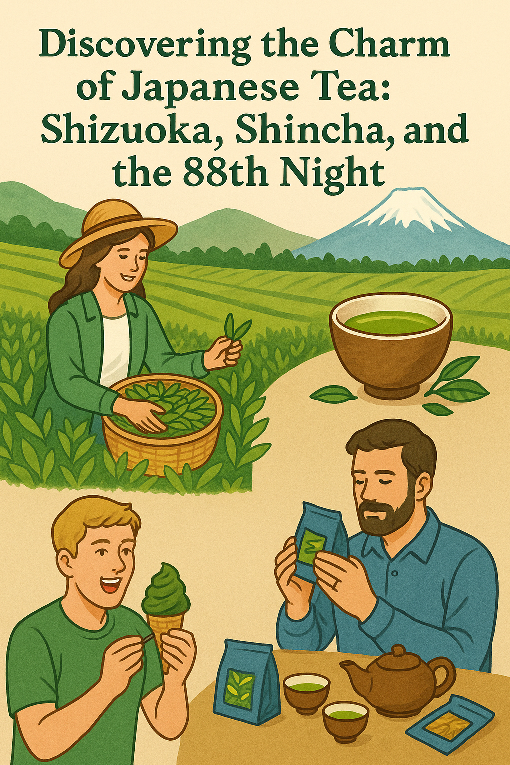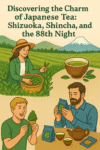
May 1, 2025
Every spring, as the calendar turns to May 1st, Japan celebrates a special seasonal milestone known as Hachijuhachiya—the 88th Night after the beginning of spring on the traditional calendar. This day marks the start of the year’s first tea harvest, known as shincha or “new tea.” For tea lovers, it’s a moment of excitement and fresh flavors, and nowhere is this more celebrated than in Shizuoka, one of Japan’s most famous tea-producing regions.
In Shizuoka’s lush green tea fields, the tender young tea leaves are picked with care—only the softest buds are selected. Many foreign visitors now travel to these areas not just to taste the tea, but to take part in the tea-picking experience themselves. Guided by local experts, participants learn to appreciate the complexity of Japanese tea through activities like cold-water brewing, which brings out the tea’s natural umami (savory taste).
One of the most widely grown tea varieties in Japan is Yabukita, accounting for around 70% of all production. During tasting sessions, visitors often try multiple tea cultivars side by side, noting the subtle differences in flavor and aroma. Many are drawn not only by the delicious taste, but also by the health benefits associated with green tea.
Meanwhile, in places like Tokyo’s Asakusa district, the Japanese tea trend takes on a more modern form—through intensely flavored matcha gelato and sweets. A popular shop offers matcha ice cream in seven levels of richness, with many tourists enthusiastically choosing the strongest level, dubbed “No. 7.” Social media platforms like TikTok have helped propel these treats to international fame, attracting long lines of curious visitors eager to try what is often called “the richest matcha in Japan.”
Beyond traditional brews and sweets, some foreign tea enthusiasts are giving Japanese tea a fresh twist. In Tokyo’s Ningyocho district, for example, a tea sommelier originally trained in wine has opened a specialty shop offering Japanese tea blended with aromatic flavors—such as muscat grape-infused green tea or caramel-scented Japanese black tea. These blends offer a gateway for those unfamiliar with Japanese tea to discover its charm through fragrance and innovation.
Japanese tea is no longer just a quiet cultural tradition—it’s a global movement. As more people around the world discover its deep flavors, health benefits, and immersive experiences, Japanese tea culture is steadily weaving itself into the hearts of global tea lovers.
日本茶の魅力を発見する:静岡、新茶、そして八十八夜
毎年春、暦が5月1日を迎えると、日本では八十八夜という特別な季節の節目が祝われます。これは、伝統的な暦における立春から88日目にあたります。この日は、その年の最初の茶の収穫、つまり「新茶」の始まりを意味します。お茶好きにとっては、わくわくする新しい味わいの瞬間であり、日本でもっとも有名なお茶の産地の一つである静岡では、これが盛大に祝われます。
静岡の青々とした茶畑では、柔らかく若い茶葉が注意深く摘み取られます。もっとも柔らかい芽だけが選ばれます。今では多くの外国人観光客がこの地域を訪れ、お茶を味わうだけでなく、自ら茶摘みに参加するためにやってきます。地元の専門家に導かれながら、冷水で淹れるなど、日本茶の自然なうまみ(旨味)を引き出す体験を通じて、その複雑さを学びます。
日本で最も広く栽培されている茶の品種の一つがやぶきたで、全生産量の約70%を占めています。テイスティングのセッションでは、訪問者が複数の品種を並べて試飲し、味や香りの微妙な違いを感じ取ります。多くの人が、おいしさだけでなく、緑茶に関連する健康効果に惹かれています。
一方、東京の浅草などでは、日本茶のトレンドがより現代的な形で現れています。非常に濃厚な抹茶ジェラートやスイーツを通じてです。ある人気の店では、抹茶アイスクリームが7段階の濃さで提供されており、多くの観光客が「7番」と呼ばれる最も濃いレベルを意気揚々と選びます。「日本で一番濃い抹茶」とも言われるこのスイーツは、TikTokなどのソーシャルメディアによって国際的に有名になり、長い列を作る観光客があとを絶ちません。
伝統的な淹れ方や甘味だけでなく、日本茶に新しいアレンジを加える外国人もいます。たとえば東京・人形町では、ワインの訓練を受けたソムリエが、日本茶に香りを加えた専門店を開いています。マスカットの香りを加えた緑茶や、キャラメルの香りが乗った日本産紅茶などがあります。これらのブレンドは、日本茶に馴染みのない人々にも、香りを通じて手に取りやすいと評判で、来店者の7割が外国人だと言われています。
日本茶の輸出額も年々増加しており、昨年は過去最高を更新しました。ジャパニーズティーは、確実に世界中のお茶好きの心をつかんでいます。
